IMG_7549
Do you have any thoughts on this post?
If BLM employees want to showcase ALL the facets of the agency’s multiple-use mission—here are the cards we’d love to see them carry
Since last week, news outlets from the Washington Post to Outside magazine have highlighted the significance of the imagery displayed prominently on “vision cards” outlining the BLM’s mission, values, and guiding principles for agency employees. A goal of improving the “health and productivity of the land to support the BLM multiple-use mission” is clearly stated on the back of the card, which is perforated to be worn clipped to a lanyard or ID badge, but the prominent illustrations are of an oil derrick and two ranchers on horseback with cattle in the distance.
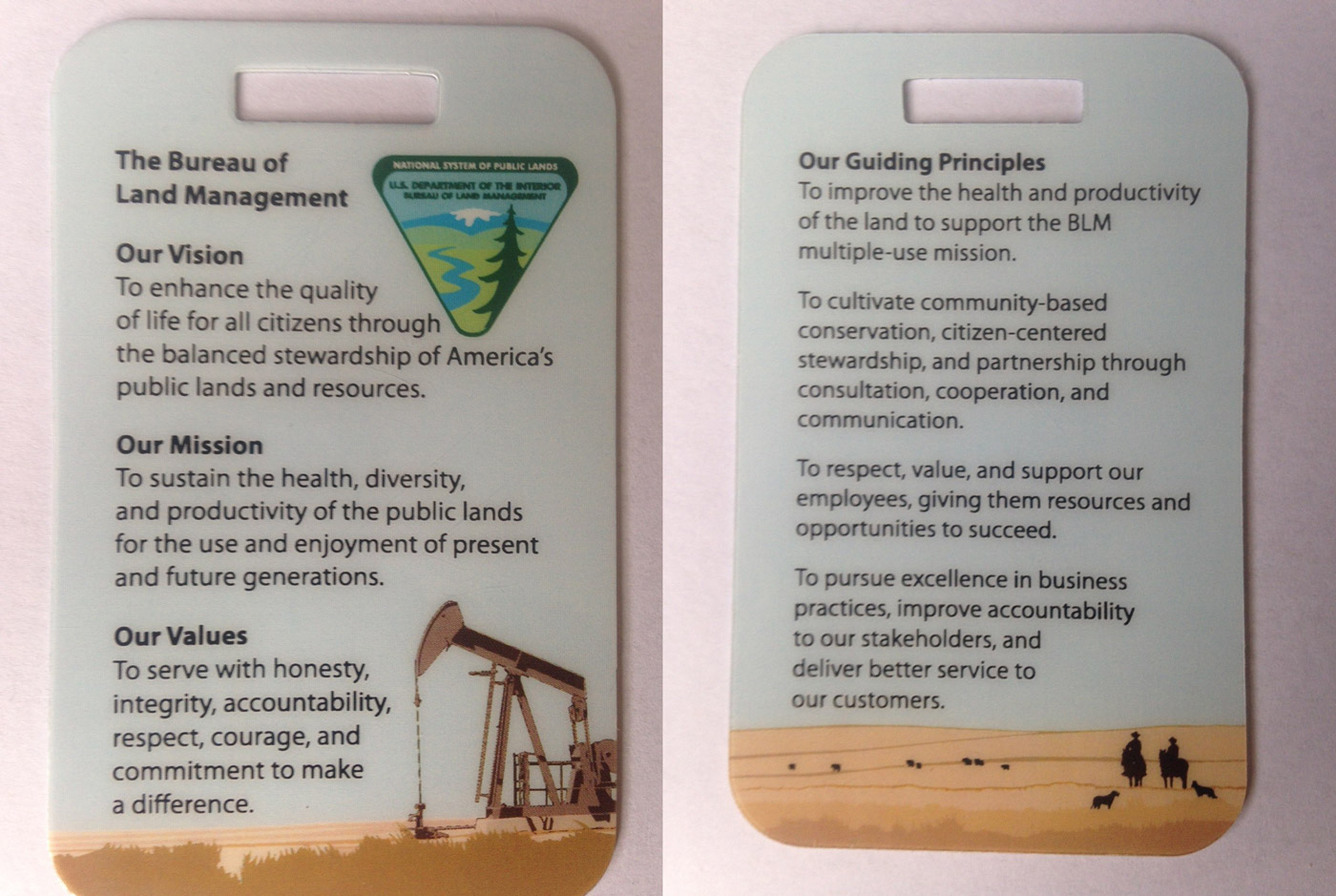
The full text on the card reads: [Front] “The Bureau of Land Management. Our Vision: To enhance the quality of life for all citizens through the balanced stewardship of America’s public lands and resources. Our Mission: To sustain the health, diversity, and productivity of the public lands for the use and enjoyment of present and future generations. Our Values: To serve with honesty, integrity, accountability, respect, courage, and commitment to make a difference.”
[Back] “Our Guiding Principles: To improve the health and productivity of the land to support the BLM multiple-use mission. To cultivate community-based conservation, citizen-centered stewardship, and partnership through consultation, cooperation, and communication. To respect, value, and support our employees, giving them resources and opportunities to succeed. To pursue excellence in business practices, improve accountability to our stakeholders, and deliver better service to our customers.”
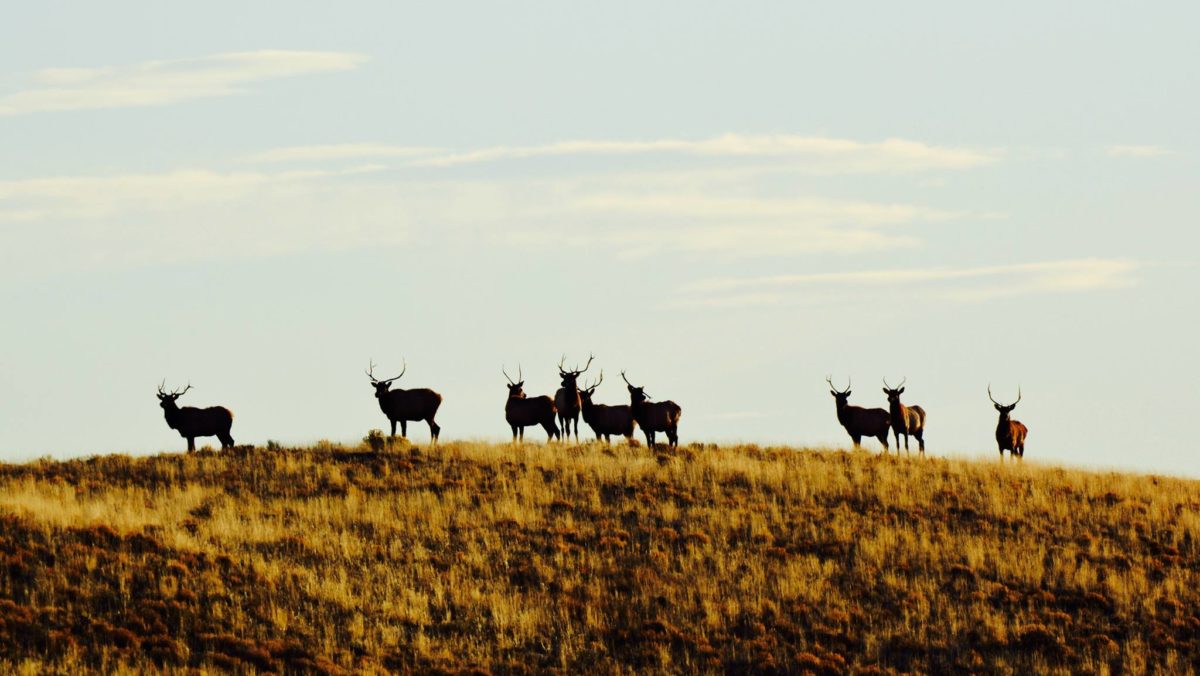
It’s possible that they simply ran out of space to depict the fish and wildlife habitat in their charge or the American hunters and anglers who rely on BLM public lands for their access. So, we took a crack at designing a few alternative versions that we’d love to see BLM employees sport around.
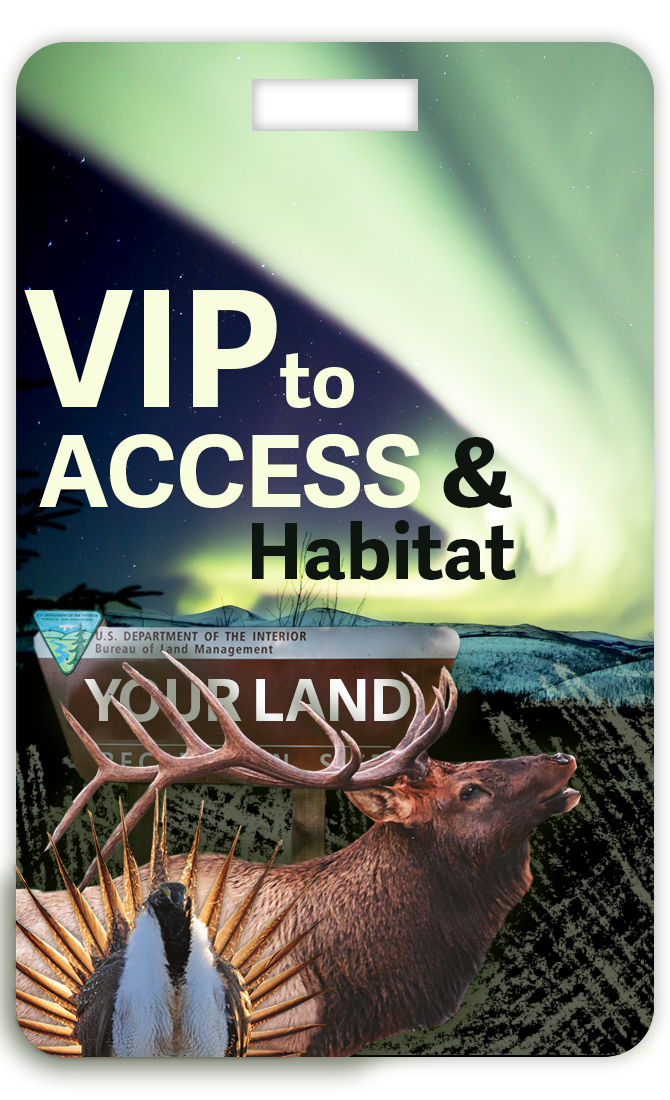
BLM employees are indeed VIPs when it comes to supporting the ability of countless sportsmen and women—regardless of their means—to pursue hunting and fishing on public land. And the agency is tasked with helping to conserve habitat and species that are critical to the future of our traditions.
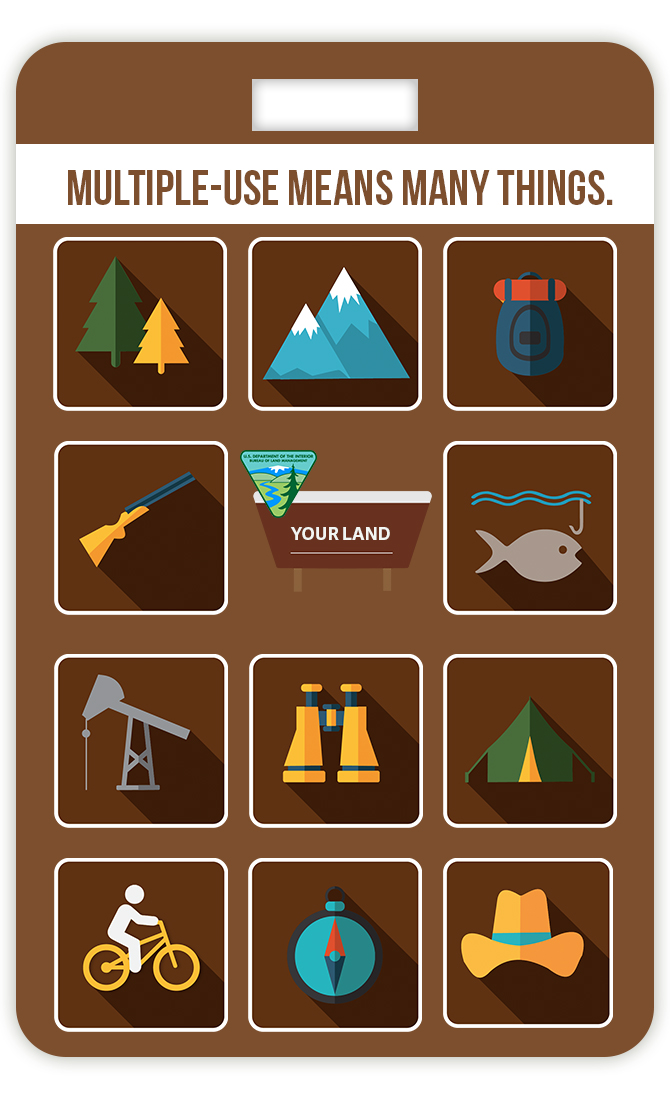
The BLM is committed to representing all stakeholders and delivering better service to its “customers”—the American people. We all deserve to be heard about the public land management decisions that may affect our businesses, communities, families, and traditions.
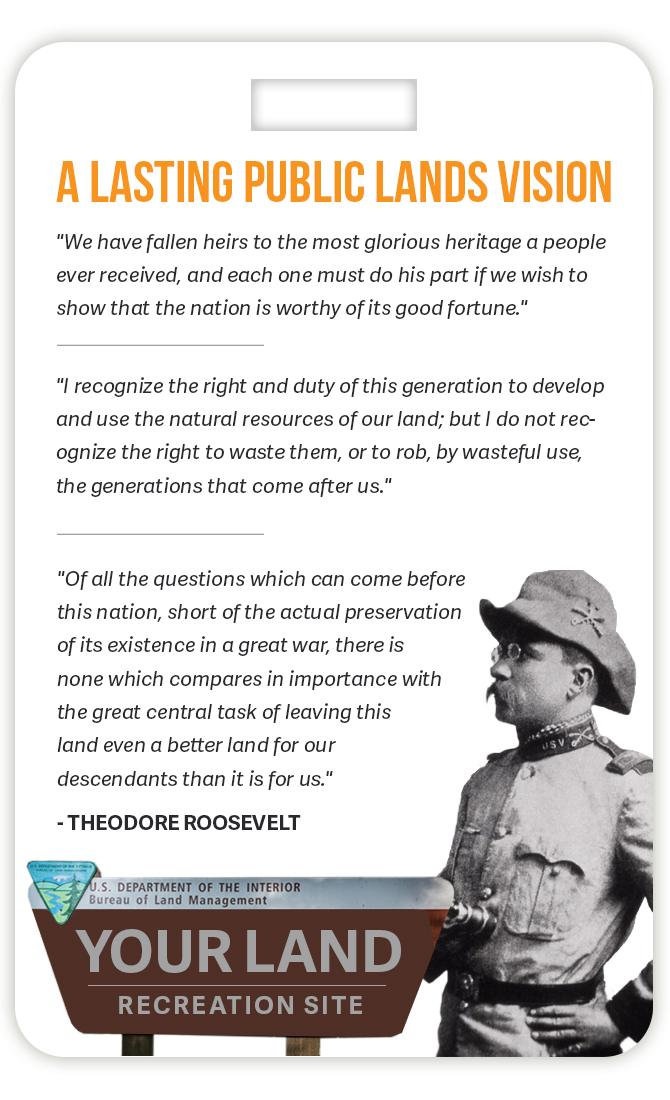
We might be biased, but when it comes to the difficult work of balancing many demands on our public lands, there is no greater source of inspiration than Theodore Roosevelt. He said:
We have fallen heirs to the most glorious heritage a people ever received, and each one must do his part if we wish to show that the nation is worthy of its good fortune.
I recognize the right and duty of this generation to develop and use the natural resources of our land; but I do not recognize the right to waste them, or to rob, by wasteful use, the generations that come after us.
And…
Of all the questions which can come before this nation, short of the actual preservation of its existence in a great war, there is none which compares in importance with the great central task of leaving this land even a better land for our descendants than it is for us.
We could all use that reminder every now and then. If you agree, click the Facebook icon on each image to easily share our vision cards on social media or print your own right now.
Cards designed by our friends at Sage Lion Media
Members of a local sportsmen’s group helped to open up 40,000 acres of state trust land in New Mexico by providing materials, volunteers, and a little elbow grease
In central New Mexico, 40,000 acres of state-owned public hunting land can be found beyond a two-track road that, until recently, dead-ended at a fence. This state trust land—home to mule deer, cougars, oryxes, pronghorns and more—is surrounded by private land, and was all but inaccessible after a gate between a ranch and state trust lands was removed and fenced over.
For a long time, all we could do was point to this spot on a map and wish we could get there. Until a group of sportsmen and women joined state officials to create a DIY solution.
There are state trust lands in 32 of New Mexico’s 33 counties. When New Mexico became a state, it was stipulated that such lands, totaling 13.4 million acres, were to be held in trust for the benefit of public schools, universities, and other beneficiary institutions. And each acre of land is designated to a specific beneficiary.
The New Mexico Commissioner of Public Lands, an elected official, is charged with generating and optimizing revenue from state trust lands to support public education and other institutions, while simultaneously working to protect, conserve, and maintain these lands for future generations. The State Land Office leases lands for grazing, agriculture, commercial use, renewable energy, oil and gas drilling, mining, and other surface and subsurface activities.
Because hunting, fishing, and trapping are key tools of fish and wildlife management, sportsmen and women are granted access to most state trust lands through easements purchased by the New Mexico Game Commission. But being allowed to hunt and fish on public land is only meaningful if we can access it.
Recently, the Commissioner of Public Lands ordered that the State Land Office make it a priority to identify and restore vehicular access to New Mexico state trust lands within the Chupadera Mesa Area, which are largely surrounded by private property and have historically been inaccessible to public land hunters. One particular pinch point was created when a gate between state trust lands and a ranch was removed, and the only entry point large enough for vehicular access was fenced over.
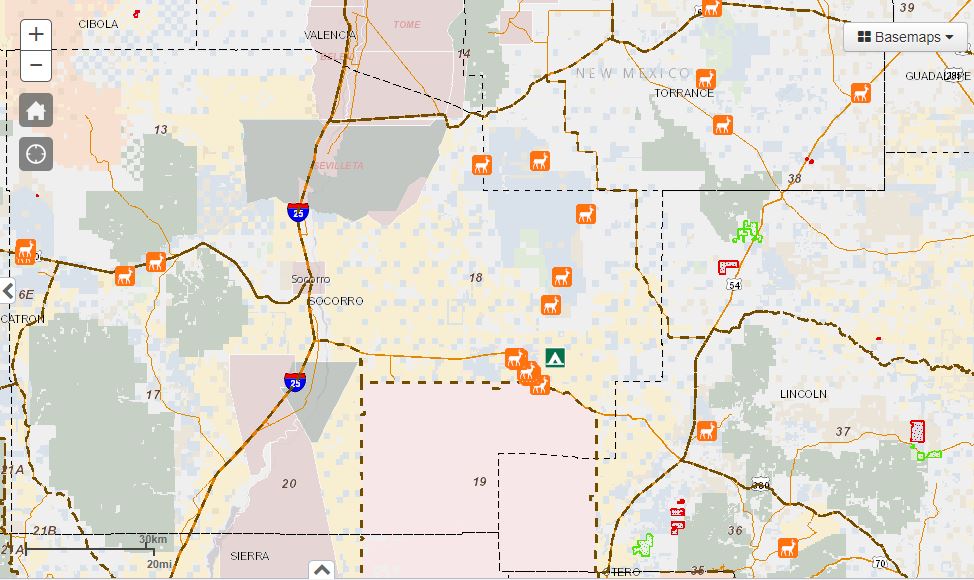
The State Land Office first approached the Doña Ana County Associated Sportsmen about the project in October 2017. Our group has forged positive relationships with government agencies and helped with hundreds of volunteer projects since the organization was founded in the early 1970s. They appealed to the club to purchase materials and provide volunteers to help complete construction of a gate that would reestablish opportunities to hunt and trap in the state land beyond the ranch.
So, in December, I went along with other members of DACAS, our families, and representatives of the State Land Office and the New Mexico Department of Game and Fish to get the job done. Fortunately, DACAS was left a generous endowment by one of its founding members to be used for scholarships in the Wildlife Department of New Mexico State University and to benefit future hunting, fishing, and trapping anywhere in New Mexico. This project was a perfect place to invest these funds to help make a difference. It took two months to coordinate volunteers and materials and three days to construct and finish the gate. And when we were done with our part, we all gathered to fire up the disco for an elk burrito lunch and stories of past hunts. A weekend afternoon is a small price to pay for access to 40,000 acres that will allow the next generation of sportsmen and women to have their own stories to tell.

It seems that when local hunters and anglers get involved and put our weight behind a solution, success is nearly always possible. The Chupadera Mesa Hunter Access Project has successfully enhanced hunting opportunities in eastern Socorro County, and I couldn’t be more proud of what our crew accomplished. But I know that a project of this scale may seem daunting to others out there, even those who truly want to make a difference.

Start small. As access to our public lands becomes increasingly pressured across the West, it is even more critical that we be willing partners with our state and federal agencies to ensure that we have quality places to hunt, fish, and trap for the foreseeable future. But we should keep an eye on the shots being called—locally and nationally.
Sign up for our updates, and we’ll let you know how to get engaged in a meaningful way. Then, sign the Sportsmen’s Country petition to let lawmakers know that we won’t take access promises over balanced management of our best fish and wildlife resources.
Our Woman Conservationist Wednesday series continues as we nerd out over angler catch data and how it can inform better marine fisheries management with the woman who oversees citizen science programs in the Southeastern states
When I invited Amber to be featured in our series of Q&As with women in conservation, I quickly discovered she and I share another uncommon affinity—a love for large datasets. As part of TRCP’s communications team, I leverage data to learn as much as I can about you, our members, and share content that resonates with you personally. Meanwhile, Amber is working to collect more reliable catch data from anglers to influence how the federal fisheries management agency, the South Atlantic Fishery Management Council will manage species in the future.
Here’s how her personal connection to fishing keeps her going in a challenging field and why she is determined to hear about what you’re catching.
TRCP: How did you begin working in fisheries management?
AMBER VON HARTEN: I grew up catching croaker in the Chesapeake Bay area and made up my mind to work in marine science in fifth grade. When you tell people you’ve dreamt of studying ocean sustainability from a young age, most picture you saving sea turtles or something. Well, my first gig was working closely with commercial fishermen within the shrimping industry, and that’s where my love of applied research began.
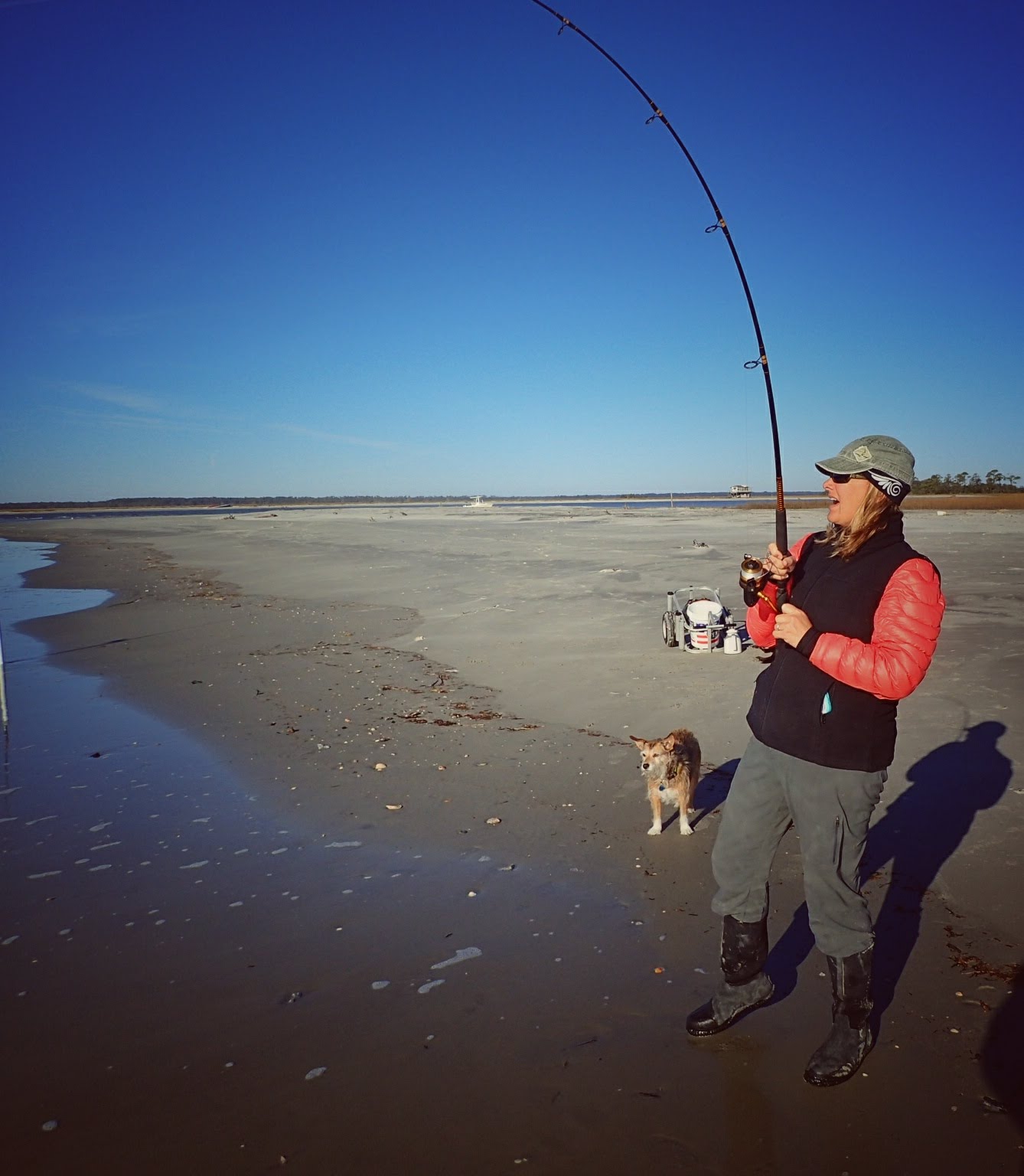
TRCP: What is the biggest challenge for the South Atlantic Fishery Management Council?
VON HARTEN: We are charged with conserving and managing 73 species of fish, seaweed, lobster, shrimp, and crab within the South Atlantic, from North Carolina all the way down to Key West. It’s a vast amount of habitat to protect, and it’s managed for both commercial and recreational fishing, where it’s hard to find a balance. The way we manage fish has biological, social, and economic impacts on coastal communities. The state of these fisheries directly affects people’s livelihoods, and that’s why the Council has one of the most rigorous processes for federal fisheries management in the world.
TRCP: What do you consider to be some of the biggest threats to the species you manage right now?
VON HARTEN: Habitat issues are always a concern. Any loss of habitat affects many species. For example, groupers spawn offshore and their young grow up in our estuaries and bays. With grouper and other species, we’ve seen some moving north and expanding their range with changes in water temperature and availability of habitat—all of a sudden, we have a species that travels out of our jurisdiction, complicating management across agencies. Fish don’t recognize state boundaries, of course and without coordinated management, the shifts in species distribution could upset the regional balance of resources in the process.
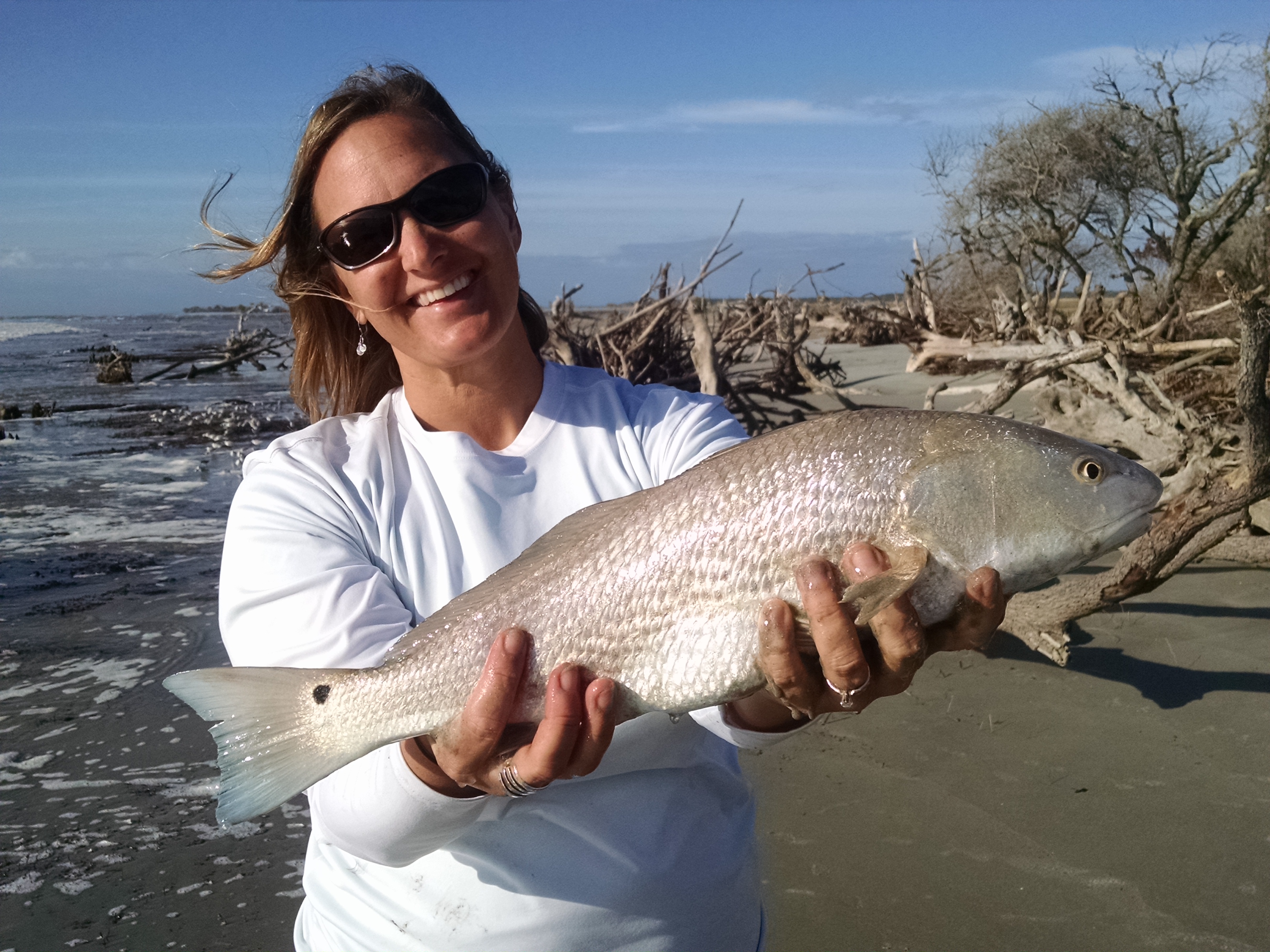
TRCP: So, how can better data help lead to better management of fish and habitat?
VON HARTEN: There is no substitute for thorough data collection. The effects of our management decisions are personal and recreational and commercial fishermen tell us all the time that they don’t trust the data that influences management decisions or their seasons.
One of the ways we are trying to think outside the box is to explore the idea of citizen science—having anglers pitch in with data collection through the use of smartphone applications. Scientists can be skeptical of the quality of self-reported data, but if you really look at current data determining fisheries management, much of it is already self-reported.
Citizen science offers a way for fishermen, scientists, and fisheries managers to all work together so that expectations are met about what data is needed for management and everyone has a shared goal in mind for how the data can be used. We hope that our latest programs will supplement existing data and fill in gaps in our current knowledge, like how many fish recreational fishermen are discarding because of their size and or because they’re a prohibited species.

TRCP: How is this different from what has been done in the past?
VON HARTEN: The use of an app to make it easier—more and more scientific fields are moving towards electronic reporting. There are lots of examples of cooperative research between scientists and fishermen, but often once the research project ends, the data sits on a shelf and isn’t revisited again. The Council’s program is pioneering the use of citizen science to supplement existing data streams using this approach.
TRCP: What continues to be your inspiration? What advice would you give other women and girls who want to take up fishing or even break into your line of work?
VON HARTEN: It was my experience fishing as a kid that made me relate to the ecology of the Chesapeake Bay area. These places are special—you can’t deny it after you’ve spent a full-moon tide up on the flats, watching the tails of the drum as they eat fiddler crabs or sight-casting to redfish.
I’d encourage young girls to believe that the sky is the limit and they’re good enough to study what interests them—even if they’re the first to do so. I was lucky to have had that kind of connection to the natural world early on, but it can be fostered at any age. It’s never too late to get your feet wet, ladies.
The most recent attempts to revive the Pebble Mine proposal and roll back sensible limits on mining activity in one of the finest fishing destinations on Earth
Even by Alaskan standards—and we’re lucky to have our pick of remote streams with big and plentiful fish—Bristol Bay is a sporting paradise. It is recognized as one of the finest fishing destinations on Earth, tucked away in an isolated corner of southwest Alaska. The region also produces about half the world’s sockeye salmon, with a record 60 million fish returning last summer to our famed rivers.
There’s no question that Bristol Bay is unique, and yet we continue to have to speak up to make sure it stays that way. Here’s why.
The now-infamous proposed Pebble Mine would carve out an open pit at the headwaters of the Bay’s two largest rivers, threatening clean water and fish habitat. Somewhere between 1.2 billion and 11 billion tons of mine waste could then remain in the area forever.
That’s why anglers, recreation businesses, tribes, chefs, commercial fishermen, conservation organizations, and hundreds of thousands of Americans came together to successfully take the proposed mine from a done deal to a less-than-popular project—it has lost three major partners, but the mine’s remaining proponent, Northern Dynasty Minerals, is still looking for new investors.
Together, we’ve successfully created major hurdles for Pebble, and in 2014, there was enough widespread public support to place sensible limits on mining in the region. In 2017, the EPA attempted to roll back limits on mining, but those who recognize the value of Bristol Bay had something to say about it—and the agency listened. The EPA received over one million public comments in response to their attempts to withdraw proposed protections for Bristol Bay, and surprisingly, the agency announced in January 2018 that they would keep these protections on the table.
Though the protections are not final, they haven’t been eliminated, as we feared. Additionally, the Army Corps of Engineers cannot issue a final permit for Pebble Mine while a review of these protections is ongoing. And while the Pebble Partnership has been touting that it has a green light on all fronts to proceed, our decision makers are expressing serious reservations about the possibility that mining in Bristol Bay can happen safely—even in a pro-development political environment. EPA Administrator Pruitt and Governor Walker both made very strong statements on the heels of the announcement to maintain protections.
Though this is a huge victory, Pebble Mine backers are gaining momentum and the fight is far from over. The vigorous support of hunters and anglers has been critical to protecting the bounty of Bristol Bay in the past. But we will to speak up again, as early as this spring.
At the end of 2017, Pebble Limited Partnership applied for the first of many dozens of permits they’ll need, and this kicked off a multi-year NEPA review and Environmental Impact Statement process. Mine opponents will continue to demonstrate at every level that for scientific, economic, and cultural reasons, Pebble should not be granted a permit.
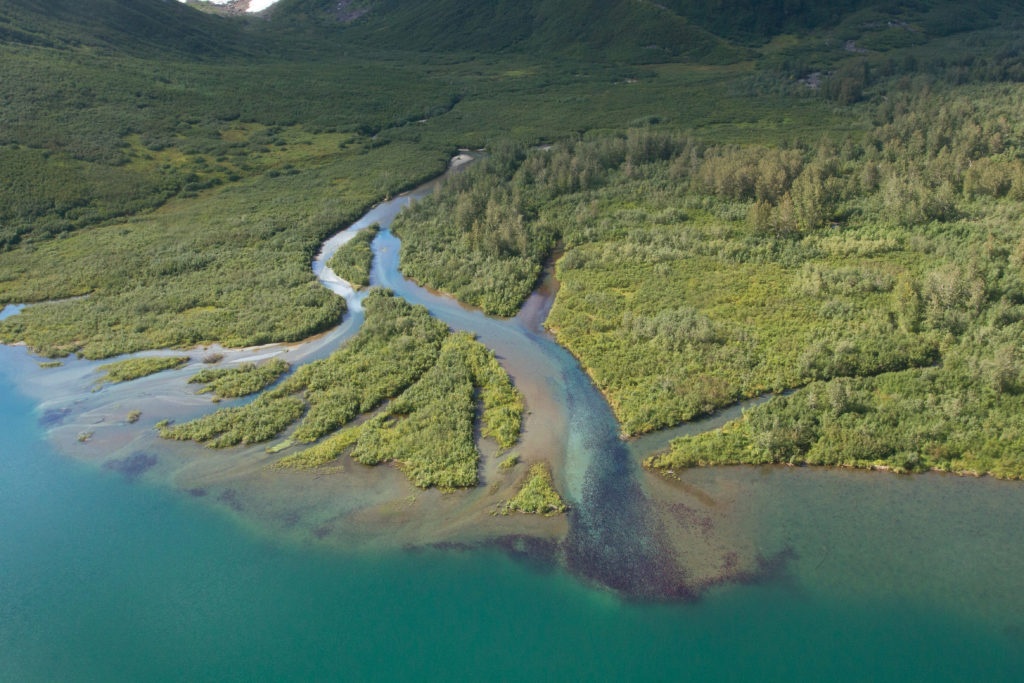
We expect the federal agencies to open a scoping comment period soon, and this is the first major step of the EIS process. Sportsmen and women need to make our voices heard once again during that process. Additionally, Alaskans are advocating for options at the state level that, if enacted, would establish higher hurdles for Pebble to overcome to get approval for its state permits.
As an Alaskan, a mother, and an angler, I’d like to thank the thousands of sportsmen and women from across the country who have already spoken up time and again to tell decision makers at all levels that Pebble Mine is not worth the risk in Bristol Bay. We’ve seen that when enough of us do so, we are heard.
Watch for your next opportunity to take action right here, at standup.tu.org/Save-Bristol-Bay, or on the Save Bristol Bay Facebook page.
Nelli Williams is Trout Unlimited’s Alaska Director. She has worked on the effort to safeguard Bristol Bay’s fish, wildlife, communities and jobs for nearly a decade. She lives in Anchorage, Alaska with her husband and two young children – they get out fishing and playing on Alaska’s rivers every chance they get.
Top photo courtesy of Ben Knight and Wild Salmon Center.
Theodore Roosevelt’s experiences hunting and fishing certainly fueled his passion for conservation, but it seems that a passion for coffee may have powered his mornings. In fact, Roosevelt’s son once said that his father’s coffee cup was “more in the nature of a bathtub.” TRCP has partnered with Afuera Coffee Co. to bring together his two loves: a strong morning brew and a dedication to conservation. With your purchase, you’ll not only enjoy waking up to the rich aroma of this bolder roast—you’ll be supporting the important work of preserving hunting and fishing opportunities for all.
$4 from each bag is donated to the TRCP, to help continue their efforts of safeguarding critical habitats, productive hunting grounds, and favorite fishing holes for future generations.
Learn More
